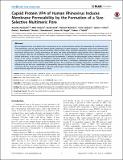| dc.contributor.author | Panjwani, Anusha | en_US |
| dc.contributor.author | Strauss, Mike | en_US |
| dc.contributor.author | Gold, Sarah | en_US |
| dc.contributor.author | Wenham, Hannah | en_US |
| dc.contributor.author | Jackson, Terry | en_US |
| dc.contributor.author | Chou, James J. | en_US |
| dc.contributor.author | Rowlands, David J. | en_US |
| dc.contributor.author | Stonehouse, Nicola J. | en_US |
| dc.contributor.author | Hogle, James M. | en_US |
| dc.contributor.author | Tuthill, Tobias J. | en_US |
| dc.date.accessioned | 2014-09-08T15:35:30Z | |
| dc.date.issued | 2014 | en_US |
| dc.identifier.citation | Panjwani, Anusha, Mike Strauss, Sarah Gold, Hannah Wenham, Terry Jackson, James J. Chou, David J. Rowlands, Nicola J. Stonehouse, James M. Hogle, and Tobias J. Tuthill. 2014. “Capsid Protein VP4 of Human Rhinovirus Induces Membrane Permeability by the Formation of a Size-Selective Multimeric Pore.” PLoS Pathogens 10 (8): e1004294. doi:10.1371/journal.ppat.1004294. http://dx.doi.org/10.1371/journal.ppat.1004294. | en |
| dc.identifier.issn | 1553-7366 | en |
| dc.identifier.uri | http://nrs.harvard.edu/urn-3:HUL.InstRepos:12785786 | |
| dc.description.abstract | Non-enveloped viruses must deliver their viral genome across a cell membrane without the advantage of membrane fusion. The mechanisms used to achieve this remain poorly understood. Human rhinovirus, a frequent cause of the common cold, is a non-enveloped virus of the picornavirus family, which includes other significant pathogens such as poliovirus and foot-and-mouth disease virus. During picornavirus cell entry, the small myristoylated capsid protein VP4 is released from the virus, interacts with the cell membrane and is implicated in the delivery of the viral RNA genome into the cytoplasm to initiate replication. In this study, we have produced recombinant C-terminal histidine-tagged human rhinovirus VP4 and shown it can induce membrane permeability in liposome model membranes. Dextran size-exclusion studies, chemical crosslinking and electron microscopy demonstrated that VP4 forms a multimeric membrane pore, with a channel size consistent with transfer of the single-stranded RNA genome. The membrane permeability induced by recombinant VP4 was influenced by pH and was comparable to permeability induced by infectious virions. These findings present a molecular mechanism for the involvement of VP4 in cell entry and provide a model system which will facilitate exploration of VP4 as a novel antiviral target for the picornavirus family. | en |
| dc.language.iso | en_US | en |
| dc.publisher | Public Library of Science | en |
| dc.relation.isversionof | doi:10.1371/journal.ppat.1004294 | en |
| dc.relation.hasversion | http://www.ncbi.nlm.nih.gov/pmc/articles/PMC4125281/pdf/ | en |
| dash.license | LAA | en_US |
| dc.subject | Biology and Life Sciences | en |
| dc.subject | Microbiology | en |
| dc.subject | Virology | en |
| dc.subject | Viral Transmission and Infection | en |
| dc.subject | Viral Entry | en |
| dc.title | Capsid Protein VP4 of Human Rhinovirus Induces Membrane Permeability by the Formation of a Size-Selective Multimeric Pore | en |
| dc.type | Journal Article | en_US |
| dc.description.version | Version of Record | en |
| dc.relation.journal | PLoS Pathogens | en |
| dash.depositing.author | Chou, James J. | en_US |
| dc.date.available | 2014-09-08T15:35:30Z | |
| dc.identifier.doi | 10.1371/journal.ppat.1004294 | * |
| dash.contributor.affiliated | Chou, James | |
| dash.contributor.affiliated | Hogle, James | |


